Your body and mind depend on proper digestion to function properly. A properly functioning digestive system gives you more energy while relieving bloating and making you feel better overall. When your gut needs added help you need some extra support. Foods high in fiber help this process work better.
Your digestive system depends on fiber as an essential nutrient to work at its best. High-fiber foods help your body move waste properly while feeding beneficial gut bacteria. They represent key nutrients for digestive health. Regularly eating fiber-rich foods proves an easy way to improve multiple digestive health concerns.

Table of Contents
We will review a selection of high-fiber foods that naturally benefit digestion in this article. This list includes vibrant fruit and veggies alongside wholesome grains with nutritious snacks to help build your happy healthier gut. Let’s explore!
The Best High-Fiber Foods Revealed
A balanced diet is key for a healthy digestive system. Eating foods high in fiber helps grow good gut bacteria and keeps bowel movements regular. It also helps with symptoms like bloating and cramps, improving overall health.
Adding more fiber to your diet has many benefits. It can lower cholesterol, control blood sugar, and help with weight management. With so many tasty, fiber-rich foods out there, making good choices is easy.
Simple changes in your eating habits can bring big benefits. Whether you’re tackling digestive issues or just want to feel better, fiber-rich foods are a great start.
Key Takeaways
- Eating High-Fiber foods supports healthy digestion and bowel function
- A diet rich in food with High-Fiber can help lower cholesterol levels and control blood sugar
- Incorporating High-Fiber foods into your diet can support healthy weight management
- There are many delicious and nutritious High-Fiber foods to choose from
- A high-fiber diet can help alleviate symptoms of digestive discomfort
- Eating food with fiber supports the growth of beneficial gut bacteria
Understanding the Role of Fiber in Your Diet
When you think about a fiber rich diet, it’s key to know how fiber helps your body. A diet full of fiber can boost your digestive health and keep blood sugar levels stable. It also helps you feel full longer, which can stop you from eating too much.
Fiber comes in two types: soluble and insoluble. Soluble fiber turns into a gel when mixed with water, which can lower cholesterol and control blood sugar. Insoluble fiber adds bulk to your stool, helping you go to the bathroom regularly. Both are important for a healthy gut, so aim for a mix in your diet.
Soluble vs. Insoluble Fiber
To get enough fiber, eat foods rich in both types. Soluble fiber is found in oats, barley, and fruits like apples and berries. Insoluble fiber is in whole wheat bread, brown rice, and veggies like broccoli and carrots.
Daily Recommended Fiber Intake
The amount of fiber you should eat daily depends on your age and sex. Most adults need 25-30 grams of fiber each day. Eating more fiber can improve your digestion and blood sugar levels. Adding fiber-rich foods to your diet can boost your health.
How Fiber Aids Digestion
A diet high in fiber supports your gut health by helping good bacteria grow and keeping bowel movements regular. It also lowers the risk of heart disease and diabetes. By eating more fiber, you can enjoy better health and digestion.
The Essential Benefits of Foods with Fiber
Incorporating the best sources of fiber into your diet is key for health. A balanced fiber food list offers vital nutrients. It helps manage blood sugar and aids in weight control. You can find these foods in fruits, veggies, whole grains, and legumes.
The main advantages of a high-fiber diet include:
- Improved digestion and regular bowel movements
- Lower cholesterol levels and reduced risk of heart disease
- Better blood sugar control and management of diabetes
- Support for healthy weight management and weight loss
Adding fiber-rich foods to your diet can bring these benefits to life. Start by exploring different fiber food lists. Then, add them to your meals. With a bit of creativity, you can make a tasty, balanced diet that supports your health.
A high-fiber diet does more than just meet fiber needs. It also nourishes your body with vitamins, minerals, and antioxidants. By choosing the best fiber sources, you’re on your way to a healthier, happier life.
Top Fiber-Rich Fruits for Digestive Health
There are many fiber-rich fruits to choose from. Adding these fruits to your meals and snacks can boost digestive health. They are natural sources of fiber that help with bowel movements and prevent constipation.
Berries, tropical fruits, and dried fruits are among the best options. These fruits are not just high in fiber but also rich in vitamins, minerals, and antioxidants. Eating a variety of these fruits ensures you get a balanced mix of nutrients for optimal health.
Berries and Their Fiber Content
Berries like raspberries, strawberries, and blueberries are great for fiber. For example, one cup of raspberries has about 4 grams of fiber. They are also low in calories and full of antioxidants, making them a fantastic diet addition.
Tropical Fruits High in Fiber
Tropical fruits like mangoes, pineapples, and papayas are also fiber-rich. A medium mango has about 2.6 grams of fiber. These fruits are tasty and add a good amount of fiber to support digestive health.
Dried Fruits as Fiber Sources
Dried fruits such as apricots, prunes, and raisins are also good for fiber. One cup of dried apricots has about 3.3 grams of fiber. They are easy to carry and can be added to meals or snacks.
| Fruit | Fiber Content (per cup) |
|---|---|
| Raspberries | 4 grams |
| Strawberries | 3 grams |
| Blueberries | 2.5 grams |
| Mangoes | 2.6 grams |
| Apricots (dried) | 3.3 grams |
Vegetables That Pack a Fiber Punch
Vegetables are a great choice for foods high in insoluble fiber. This type of fiber helps with digestion and prevents constipation. Adding different high-fiber vegetables to your meals boosts nutrition.
Broccoli, carrots, and Brussels sprouts are top picks for foods high in insoluble fiber. They’re not just fiber-rich but also full of vitamins and minerals. For instance, broccoli is loaded with vitamin C and K, while carrots are rich in vitamin A.
To get the most from foods high in insoluble fiber, try these tips:
- Eat a variety of colorful vegetables to ensure you’re getting a range of nutrients
- Include raw or lightly cooked vegetables in your meals to preserve their fiber content
- Experiment with different cooking methods, such as roasting or grilling, to bring out the natural flavors of high-fiber vegetables
Here is a table summarizing some high-fiber vegetables and their nutritional benefits:
| Vegetable | Fiber Content (per 100g) | Nutritional Benefits |
|---|---|---|
| Broccoli | 2.6g | Rich in vitamin C and vitamin K |
| Carrots | 2.9g | High in vitamin A |
| Brussels Sprouts | 4.1g | Rich in vitamin C and vitamin K |
Whole Grains: Your Daily Fiber Champions
Whole grains are a great choice for low carb high fiber foods. They are full of dietary fiber, which is key for a healthy gut. Foods like brown rice, quinoa, and whole-wheat bread are rich in fiber and nutrients. They help lower cholesterol and control blood sugar.

Adding whole grains to your diet is simple and tasty. Try swapping refined grains for whole grains in your meals. Use whole-grain bread instead of white, and brown rice instead of white. Also, try ancient grains like Kamut, spelt, and bulgur for more fiber and nutrients.
Ancient Grains and Their Benefits
Ancient grains are whole grains that keep their nutrients. They are full of fiber, protein, and healthy fats. This makes them perfect for a low carb high fiber diet. Some top ancient grains are:
- Quinoa: high in protein and fiber
- Kamut: rich in fiber and nutrients
- Spelt: high in fiber and protein
Choosing the Right Bread Products
When picking bread, choose whole grain options with less sugar and preservatives. Look for bread that feels dense and heavy. It usually has more fiber and nutrients. Good choices include whole-grain, sourdough, and sprouted grain bread.
Legumes and Pulses: Superior Sources of Dietary Fiber
Legumes and pulses are top choices for high fiber foods. They are full of dietary fiber and protein. This makes them great for a fiber rich diet. Popular ones include lentils, chickpeas, black beans, and kidney beans.
These foods are easy to use in many dishes. You can add lentils to soups or stews for extra fiber and protein. Chickpeas are great on salads. Here’s a list of some legumes and pulses and their fiber content:
| Legume/Pulse | Fiber Content (per 1 cup cooked) |
|---|---|
| Lentils | 15.6 grams |
| Chickpeas | 12.5 grams |
| Black beans | 9.5 grams |
| Kidney beans | 8.2 grams |
Eating legumes and pulses can help your health a lot. They support good digestion and blood sugar levels. Their high fiber and versatility make them perfect for a fiber rich diet.
Nuts and Seeds: Compact Fiber Powerhouses
Nuts and seeds are often overlooked, but they are packed with fiber. You can add them to meals or eat them as snacks. A good High-Fiber food list should include many types of nuts and seeds.
Best Nuts for Fiber Content
Almonds, pistachios, and hazelnuts are great for fiber. They also have healthy fats and protein. Add them to oatmeal, yogurt, or salads for more fiber.
Seed Varieties and Their Fiber Profiles
Chia, flax, and hemp seeds are full of fiber and omega-3s. Use them in smoothies, salads, or as egg substitutes. Here’s a look at their fiber content:
- Chia seeds: 10 grams of fiber per ounce
- Flaxseeds: 8 grams of fiber per ounce
- Hemp seeds: 7 grams of fiber per ounce
Adding nuts and seeds to your diet boosts fiber. They’re great for your health. Simple changes can make a big difference in your fiber intake.
Low-Carb Options for High-Fiber Intake
Following a low-carb diet can make it hard to get enough fiber. But, there are many low carb High-Fiberfoods to help. Vegetables like broccoli, cauliflower, and leafy greens are low in carbs but high in fiber.
Nuts and seeds, such as almonds, chia seeds, and flaxseeds, are also good. They’re not just high in fiber but also in healthy fats and protein. Adding foods like avocado, which is rich in fiber and healthy fats, is also a great idea.
Here are some examples of low carb High-Fiber foods you can add to your diet:
- Vegetables like broccoli, cauliflower, and leafy greens
- Nuts and seeds like almonds, chia seeds, and flaxseeds
- Avocado
Always choose whole, unprocessed foods. Limit processed and packaged foods. By adding these low carb High-Fiber foods to your diet, you can meet your fiber needs while on a low-carb diet.
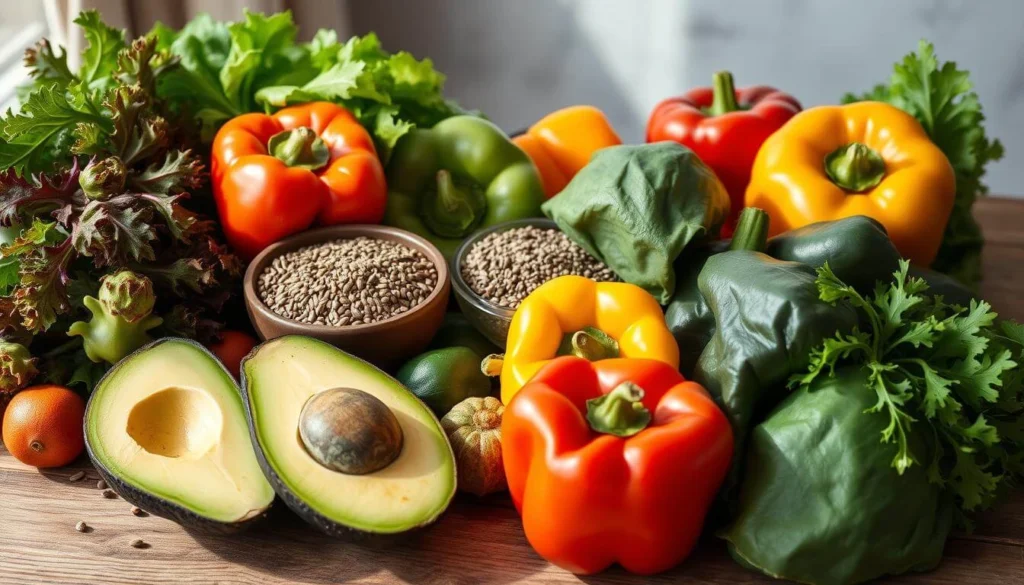
Creating a Fiber-Rich Meal Plan
To make a meal plan rich in fiber, focus on adding foods high in insoluble fiber and fiber-rich fruits. Start by picking high-fiber foods you like. Then, find ways to include them in your breakfast, lunch, and dinner.
Begin by trying different breakfasts, like oatmeal with fruit or whole-grain toast with avocado. For lunch and dinner, add legumes, whole grains, and various vegetables. Healthy snacks include fruits, carrot sticks with hummus, and nuts.
Foods high in insoluble fiber include whole wheat bread, brown rice, and broccoli. Fiber-rich fruits like apples, bananas, and berries are also excellent choices. Adding these to your diet helps create a balanced meal plan that supports your digestive health.
Here are some tips to help you get started:
- Start your day with a high-fiber breakfast, such as oatmeal with fruit or whole-grain toast with avocado
- Incorporate legumes, whole grains, and a variety of vegetables into your lunch and dinner meals
- Choose healthy snacks, such as fruits, carrot sticks with hummus, and nuts
By following these tips and adding foods high in insoluble fiber and fiber-rich fruits to your meals, you can start a healthier diet.
Tips for Gradually Increasing Your Fiber Intake
Starting a fiber rich diet should be done slowly. This helps your body adjust without discomfort. A fiber rich diet boosts your digestive health and helps control blood sugar.
To boost your fiber, add more High-Fiber-rich foods to your meals. Try berries, leafy greens, or whole grains. Here are some tips to begin:
- Start with small increments: Increase your fiber intake by 2-3 grams per day to allow your digestive system to adjust.
- Choose a variety of foods: Include a range of fiber-rich foods in your diet to ensure you’re getting a broad range of nutrients.
- Drink plenty of water: Adequate hydration is essential for fiber to move through your digestive system.
By following these tips and making gradual changes, you can adopt a High-Fiber rich diet successfully. Enjoy the health benefits it offers.
Common Mistakes to Avoid When Adding Fiber to Your Diet
Adding High-Fiber foods to your diet can be tricky. Knowing common mistakes helps avoid discomfort or side effects. A fiber-rich diet boosts your health. Here are some tips to make the transition smooth.
Drinking enough water is key when you eat more fiber. It helps fiber move through your body, preventing constipation or bloating. Also, eat high-fiber foods at the right time to keep your bowel movements regular.
Portion Control Guidelines
It’s important to control your portions with High-Fiber foods. Start with small amounts and slowly increase. This way, your body can adjust. Too much fiber can be bad, but the right amount is good for you.
Some key points to remember when adding fiber to your diet include:
- Drink at least 8-10 glasses of water per day
- Space out your fiber intake throughout the day
- Start with small servings and increase gradually
By avoiding these common mistakes, you can enjoy the benefits of a high-fiber diet. This includes better digestion and overall health. Always remember to drink enough water, eat at the right time, and control your portions.
| Fiber-Rich Food | Serving Size | Fiber Content |
|---|---|---|
| Apple | 1 medium | 4.5 grams |
| Broccoli | 1 cup cooked | 5.1 grams |
| Almonds | 1 ounce | 3.5 grams |

Conclusion: Embracing a Fiber-Rich Diet for Better Digestive Health
Adding more food with High-Fiber to your diet can greatly improve your digestive health. Focus on fiber-rich foods like fruits, vegetables, whole grains, legumes, nuts, and seeds. These can help with regular bowel movements and improve gut function.
A fiber-rich diet does more than aid digestion. It also helps stabilize blood sugar, lowers heart disease risk, and may prevent some cancers. Start by slowly adding more fiber to your diet. Make sure to drink plenty of water for a smooth transition.
Choosing a fiber-rich lifestyle is a simple yet effective way to boost your digestive health. Add the best fiber-rich foods to your meals and snacks. Enjoy the benefits of a healthy, well-nourished gut.
FAQ
What are the best sources of dietary fiber?
The best sources of dietary fiber are fruits, vegetables, whole grains, legumes, nuts, and seeds. Focus on berries, tropical fruits, leafy greens, beans, lentils, oats, quinoa, chia seeds, and almonds for high fiber.
How much fiber do I need in my daily diet?
Adults need 25-30 grams of fiber daily. Your needs may vary based on age, gender, and health. Always check with a healthcare professional for your specific needs.
How does dietary fiber support digestive health?
High-Fiber is key for digestive health. Soluble fiber helps with bowel movements and can ease symptoms of constipation and diarrhea. Insoluble fiber adds bulk to stool, promoting regular bowel movements.
What are the differences between soluble and insoluble fiber?
Soluble fiber dissolves in water, helping lower cholesterol and regulate blood sugar. Insoluble fiber doesn’t dissolve and adds bulk to stool, aiding regular bowel movements. Both are vital for digestive health.
What are some of the top fiber-rich fruits and vegetables?
Top High-Fiber-rich fruits include berries and tropical fruits like guava, mangoes, and papayas. Leafy greens, broccoli, Brussels sprouts, artichokes, and peas are high in fiber vegetables.
How can I incorporate more fiber-rich foods into my diet?
Add more fruits and vegetables to your meals. Choose whole grain breads and cereals. Include beans, lentils, nuts, and seeds in your dishes. Gradually increase fiber intake to help your digestive system adjust.
Are there any low-carb options for getting more fiber?
Yes, non-starchy vegetables like leafy greens, broccoli, and cauliflower are low-carb and high in fiber. Also, consider nuts, seeds, and fruits like berries and avocado.
What are some common mistakes to avoid when increasing fiber intake?
Avoid not drinking enough water and adding too much fiber too quickly. Also, don’t forget to balance your fiber intake throughout the day. Gradually increase fiber and stay hydrated for a smooth transition.

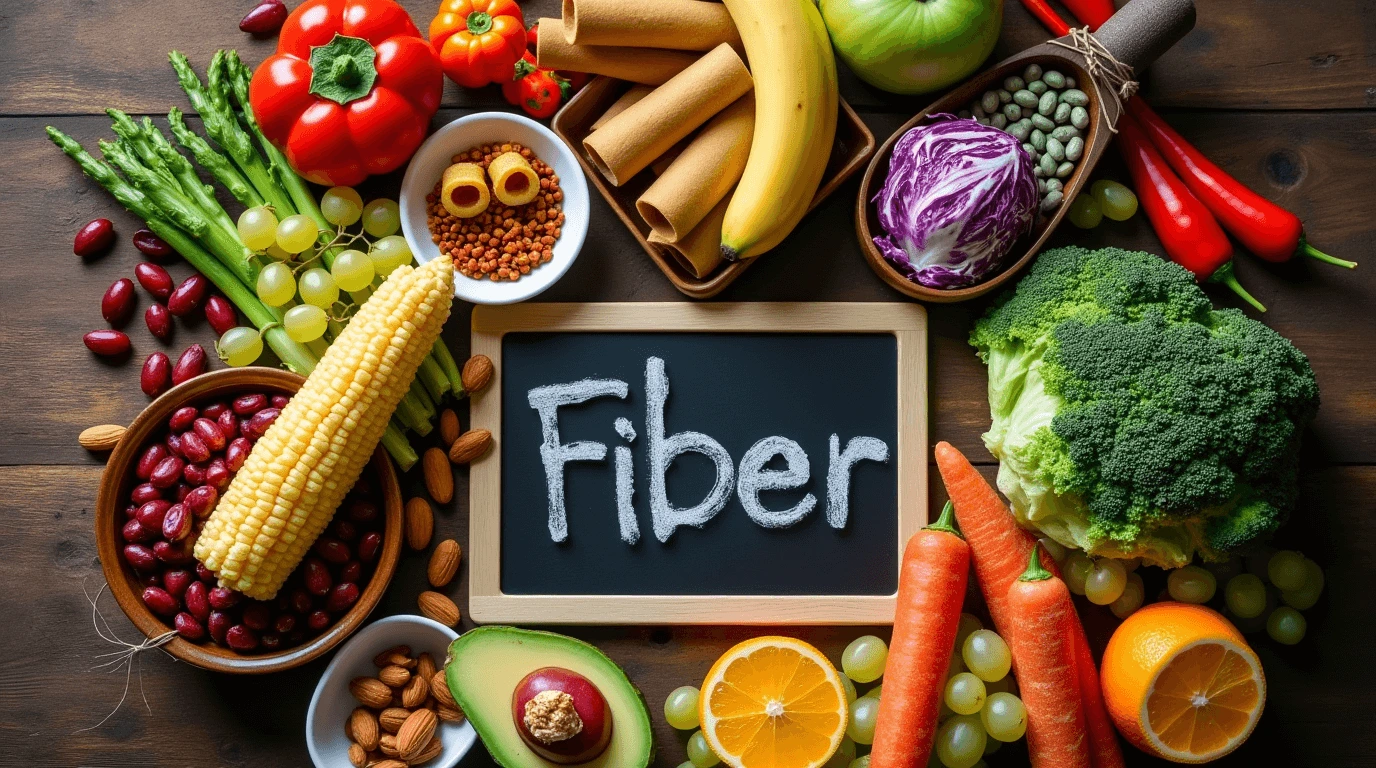
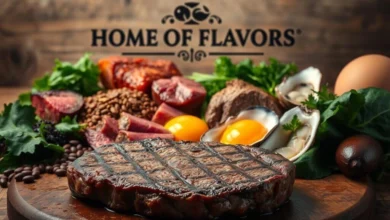
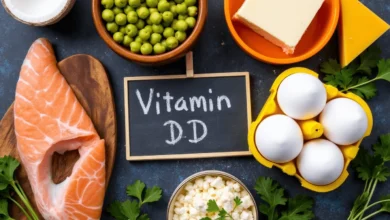
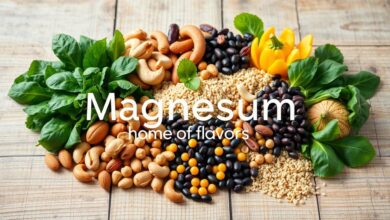
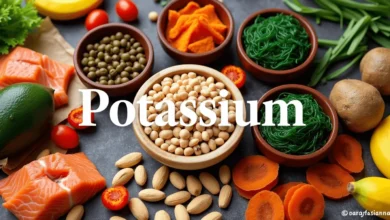
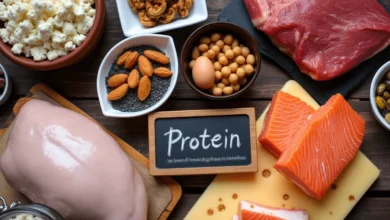




2 Comments